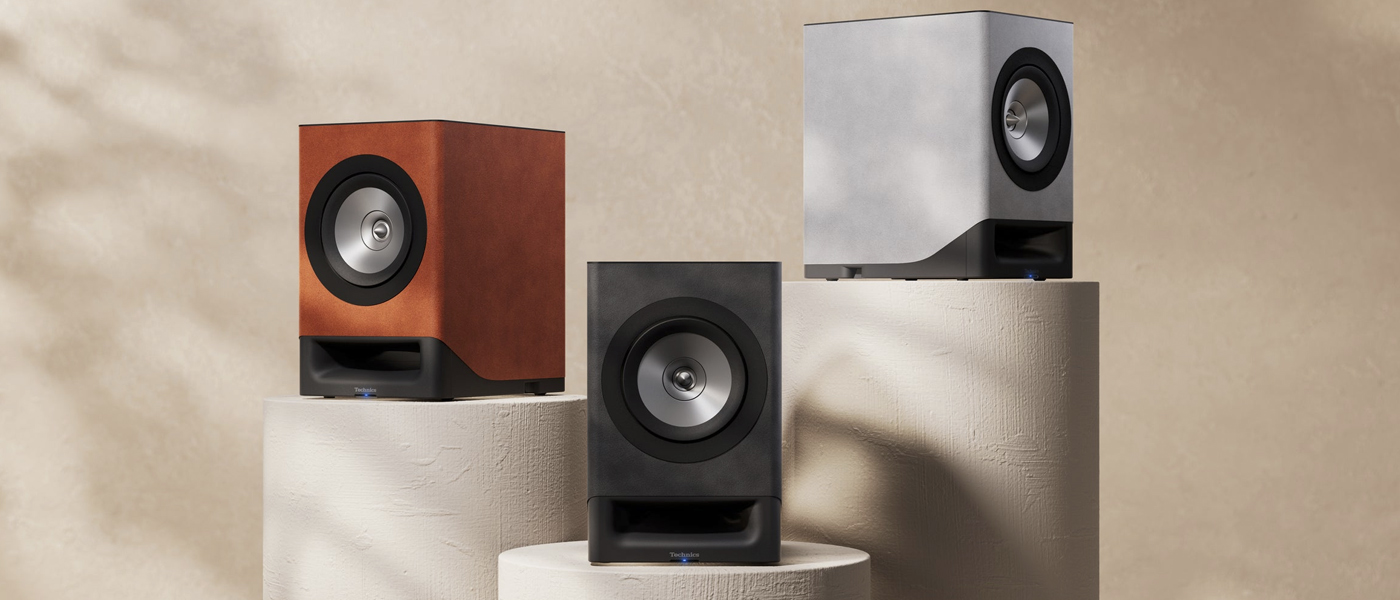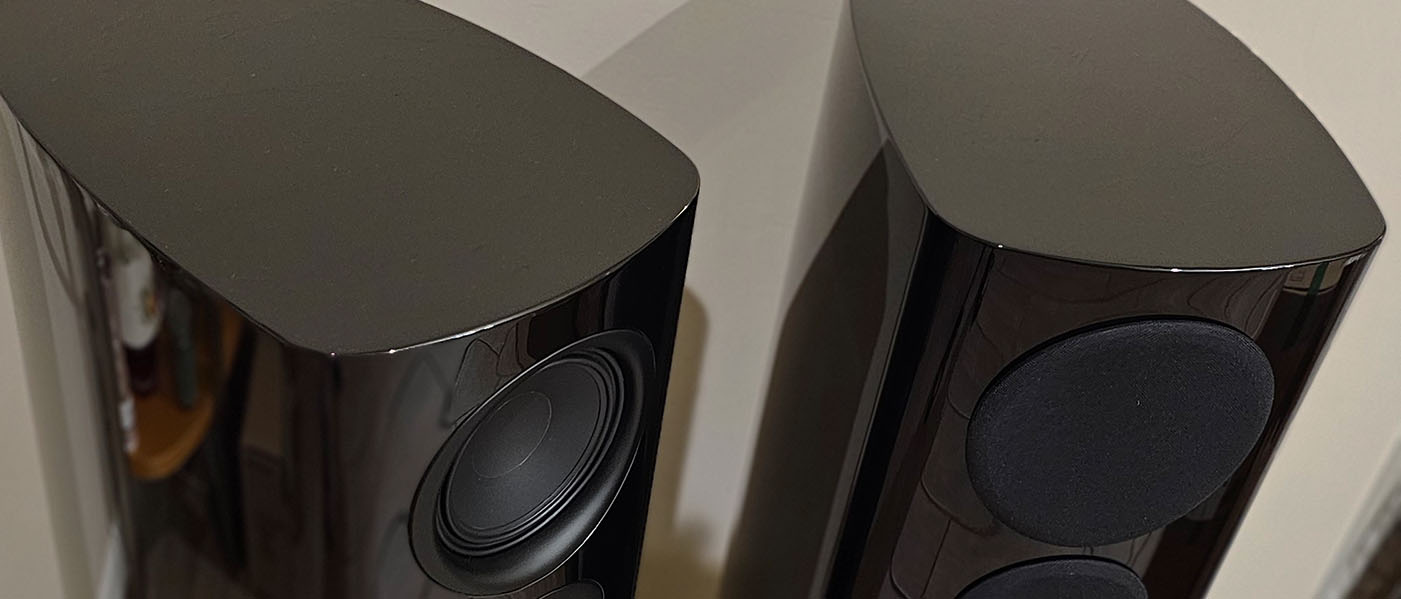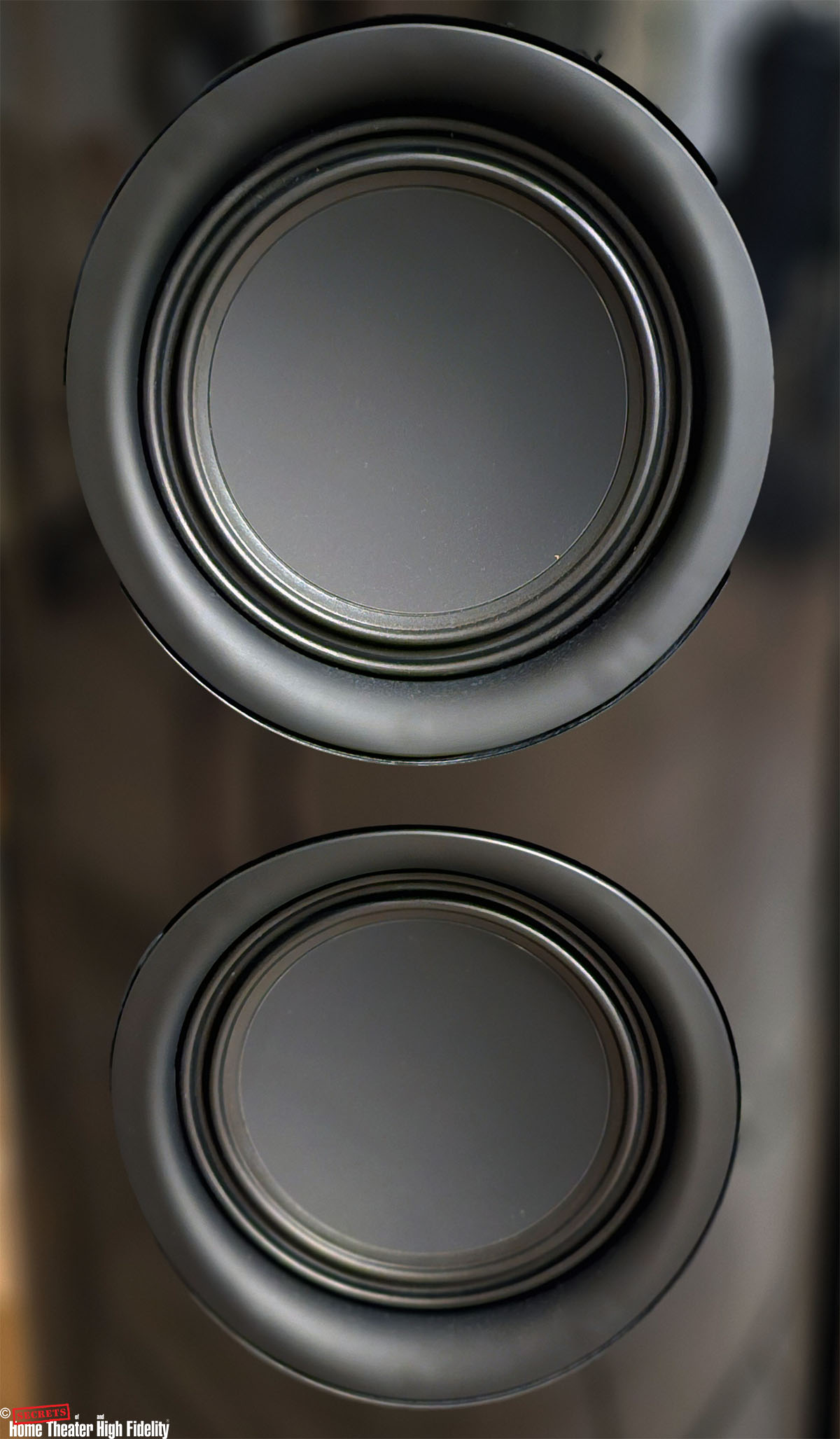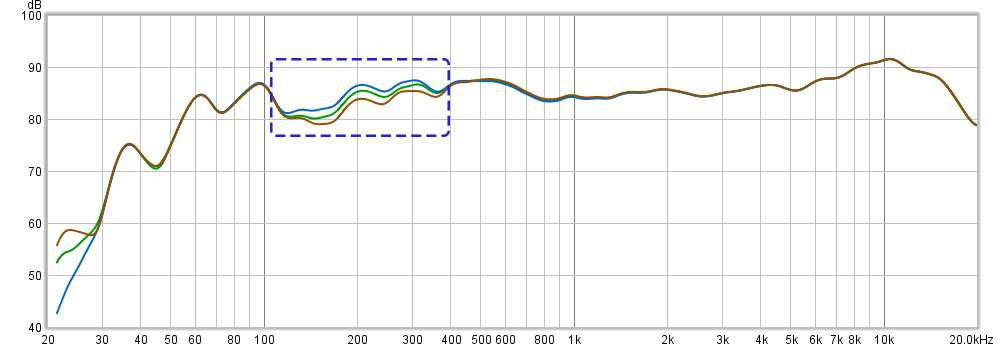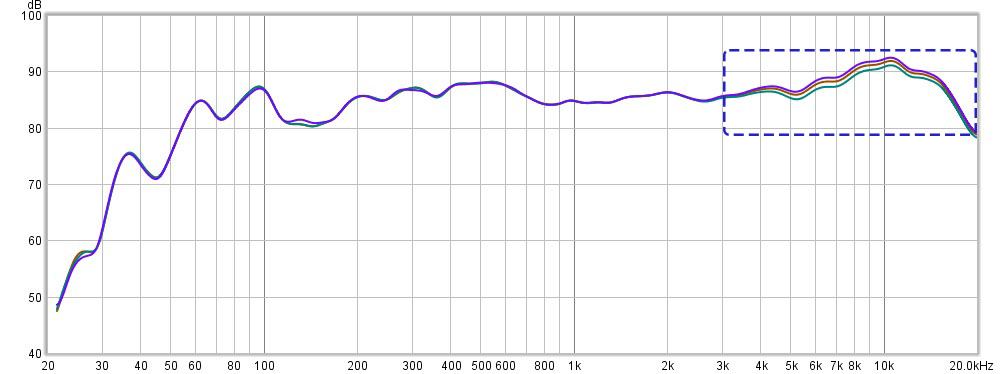The Reference series epitomizes the pinnacle of speaker design from Canton, a German speaker manufacturer with over 50 years of experience in the industry. This series is characterized by cutting-edge design approaches, exemplifying advanced engineering and premium materials in aesthetically appealing design. Standing at approximately 39” tall, the Reference 7 is the smallest floor-standing speaker within the new Reference series. As such, the Reference 7 positions itself as an attractive solution for applications in small to medium-sized spaces.
Canton Reference 7 Floor-Standing Speakers
- Slim three-way configuration floor-standing speakers.
- Appealing cabinet design with excellent construction and finish quality.
- High-quality materials all around.
- Engineered for high-fidelity sonic reproduction.
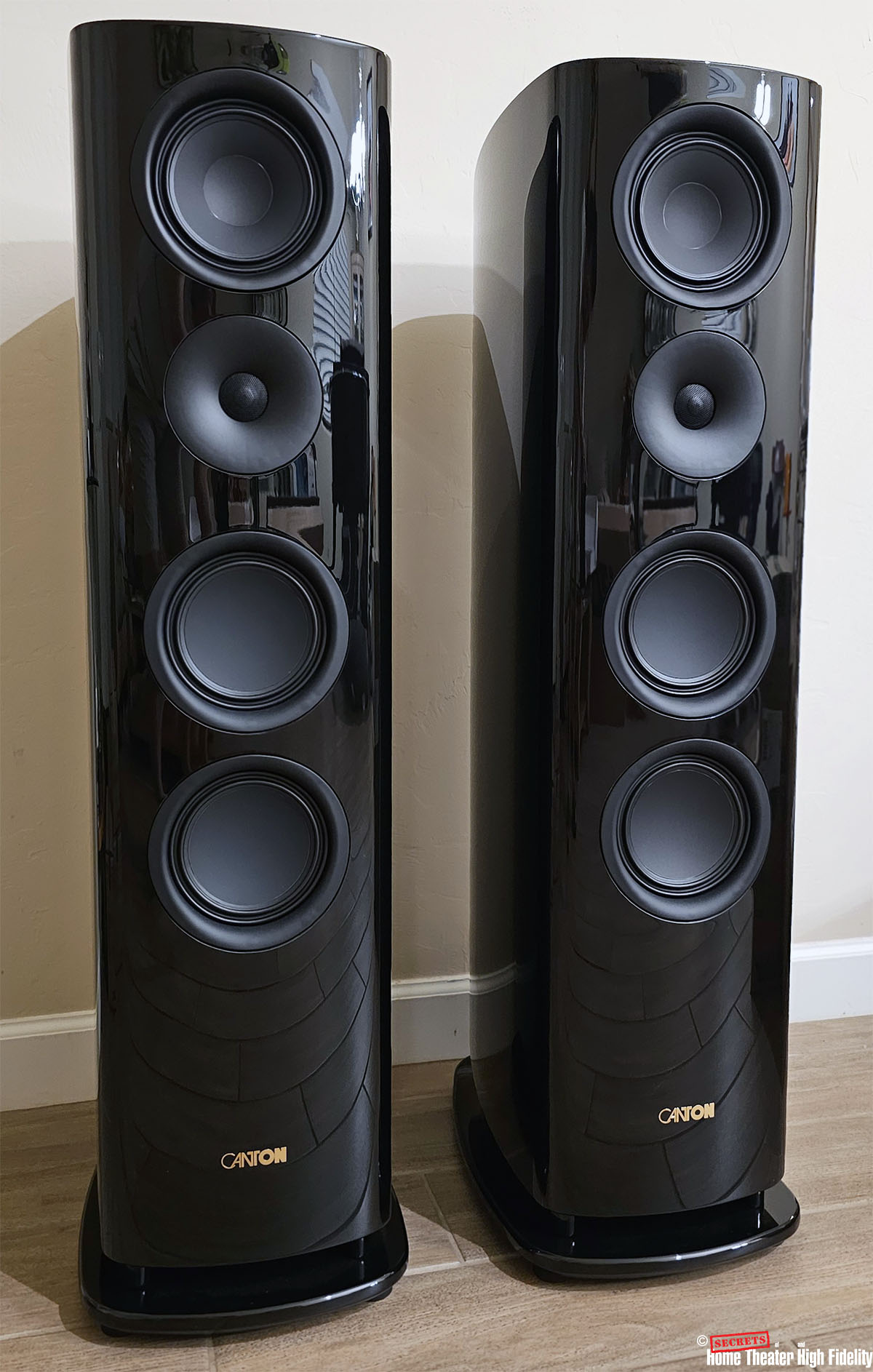 Canton Reference 7 speakers in glossy black finish
Canton Reference 7 speakers in glossy black finish
Canton is an established speaker brand in the audio industry. The Canton Vento 100 speakers, which I reviewed approximately 2.5 years ago, have made a significant impression on me. Since then, Canton has become one of my favorite manufacturers of high-fidelity speakers.
Canton produces a wide range of speaker models for various applications, with the Reference series as its flagship lineup. The speakers within the Reference series showcase Canton’s advanced design and engineering expertise, featuring innovative use of materials, advanced driver technology, and meticulous craftsmanship. Each model in the Reference line is developed from scratch, ensuring they are unique creations tailored for exceptional audio performance rather than mere iterations of prior models.
The Canton Reference series offers a comprehensive selection, featuring five floor-standing models, one stand-mount model, a center speaker, and a subwoofer. It is possible to assemble a complete home theater speaker system using exclusively the speakers from the Reference series. This review will focus on the Reference 7 speakers for stereo applications.
Type:
Floor-standing Speaker
Design:
3-way bass reflex system
Nominal/Music power handling:
160/320 Watts
Frequency response:
23 Hz – 40 kHz
Crossover frequency:
190 / 3,200 Hz
Woofer:
2 x 6″ Black Ceramic Tungsten (Wave surround)
Midrange:
1 x 6” Black Ceramic Tungsten (Wave surround)
Tweeter:
1 x 1” Aluminum Ceramic Oxide
Impedance:
4-8 Ohms
Warranty:
10 years
Dimensions (WxHxD):
11″ x 38.5″ x 17″
Weight:
73 lbs each
Available finishes:
Standard: high-gloss black or white
Premium: walnut
MSRP:
$8,000/pair for standard finish
$9,000/pair for premium finish
Website:
Company:
SECRETS Tags:
Canton, Reference 7, Floor-Standing Speakers
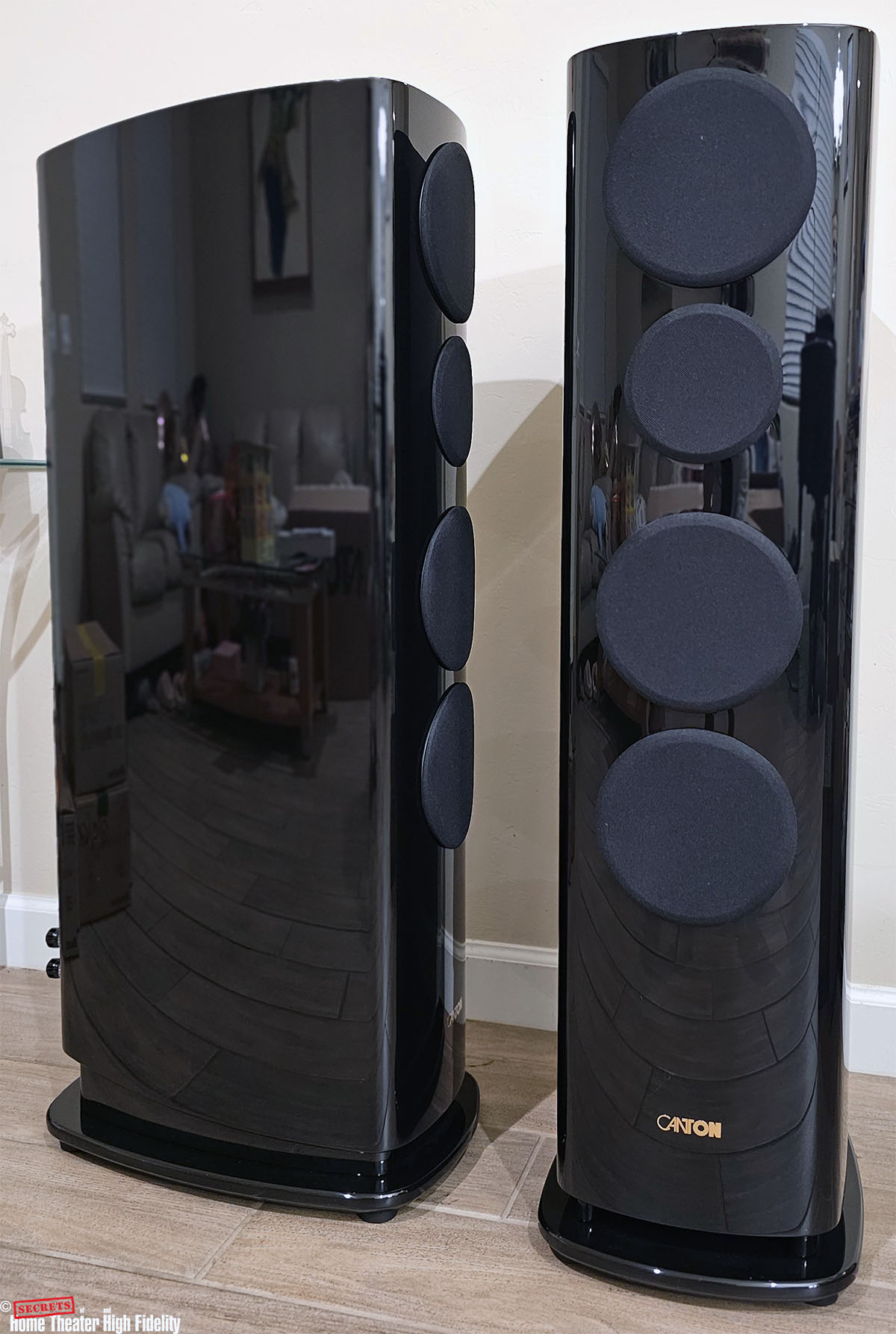 Canton Reference 7 speakers front and side view
Canton Reference 7 speakers front and side view
Secrets Sponsor
As the smallest floor-standing speaker model in the Canton Reference series, the Reference 7 positions itself as the most suitable floor-standing model for space-conscious applications. Actually, the difference in height between the Reference 7 and the three floor-standing models above it in the Reference series (Reference 5, Reference 3, and Reference 2) are not that significant, and they all employ the same number of drivers (a tweeter, a midrange, and two woofers) in the same configuration. However, the higher models in the series employ larger woofer sizes. The Reference 7 utilizes a 1” aluminum ceramic oxide tweeter, a 6” Black Ceramic Tungsten (BCT) midrange driver, and two 6” BCT woofers on each speaker in a three-way bass-reflex design. Canton claims that these newly developed BCT membranes offer a perfect stiffness-to-weight ratio for achieving accurate music reproduction.
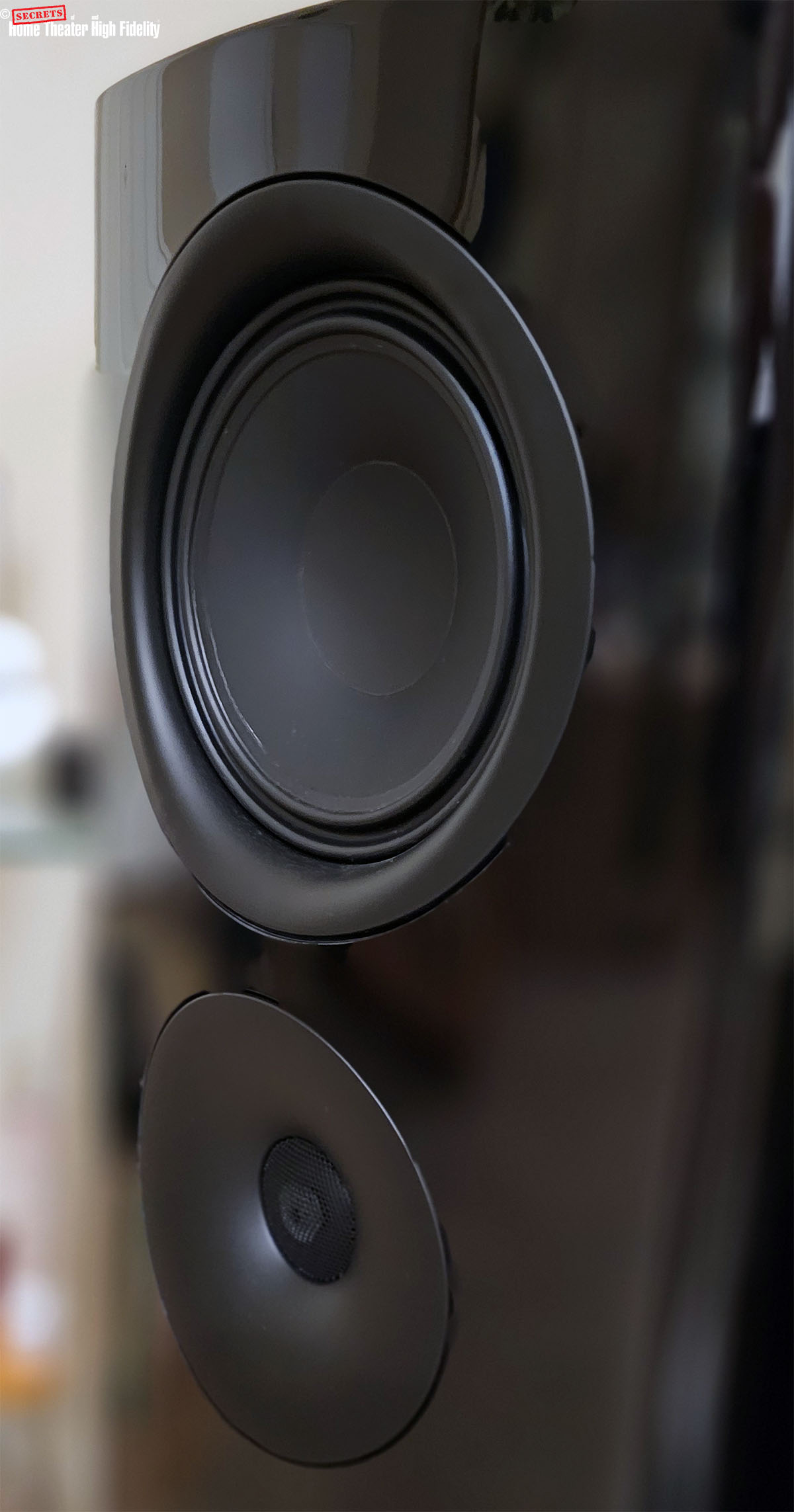 Canton Reference 7 tweeter and midrange drivers
Canton Reference 7 tweeter and midrange drivers
Once the speakers were out of their boxes, I immediately marveled at their excellent craftsmanship. These speakers feature an all-curved baffle design with a high-grade glossy finish that is visually appealing and décor-friendly. The cabinet is made of MDF of various thicknesses (2” front baffle, 1.5” rear baffle, and 3⁄4” everywhere else). The front, sides, and rear baffles are blended nicely with gently curved corners all around. Even the top baffle sports a bit of curvature and inclines upward from the back to the front. Because of the curved baffle, each of the drivers is fitted with a specifically shaped ring to make it snugly fit in its location. These rings, which also serve as asymmetrical wave guides for the drivers, are made of low-resonance material that also increases the mechanical stability of the system. Fabric grilles with magnetic attachments are included. Each grille is custom-fitted for each driver of the speaker. Hence, there are 4 individual grilles for each speaker.
The cabinets are well braced and sturdy, with each speaker weighing 73 lbs. The review samples come in a gloss black finish. Other finishes offered are gloss white and premium walnut, with the latter costing an additional $1,000/pair.
The Reference 7 cleverly hides the downward-facing bass port through the use of a “floating” cabinet design. The underside of the cabinet, where the port lies, is supported at a specific height above the base plinth using two angled walls, which also serve as a bass guide for dispersing bass frequencies more evenly from the front and rear. Although not totally free from bass reflection from the wall behind the speakers, I found that such a design reduced this effect. As a result, this design offers more flexibility concerning placement against the wall behind the speakers. The bottom part of the base plinth is equipped with four height-adjustable feet.
Canton equipped the Reference 7 with high-quality WBT-nextgen speaker terminals. Each speaker has two pairs of these terminals to accommodate biwiring/biamping applications. By default, the two sets of terminals are connected by metal jumpers for single-wiring applications. The speakers were evaluated in this default jumper setting.
Located above the speaker terminals are jumpers that facilitate tweeter and midrange compensation. These jumpers offer three settings: + (to increase the level from default), 0 (default), and – (to reduce the level from default). The speakers are shipped with the jumpers set to the ‘0’ position. Adjusting the midrange and tweeter levels allows for customization of the sound output according to individual preferences, enhances compatibility with upstream components, and mitigates certain room acoustics effects.
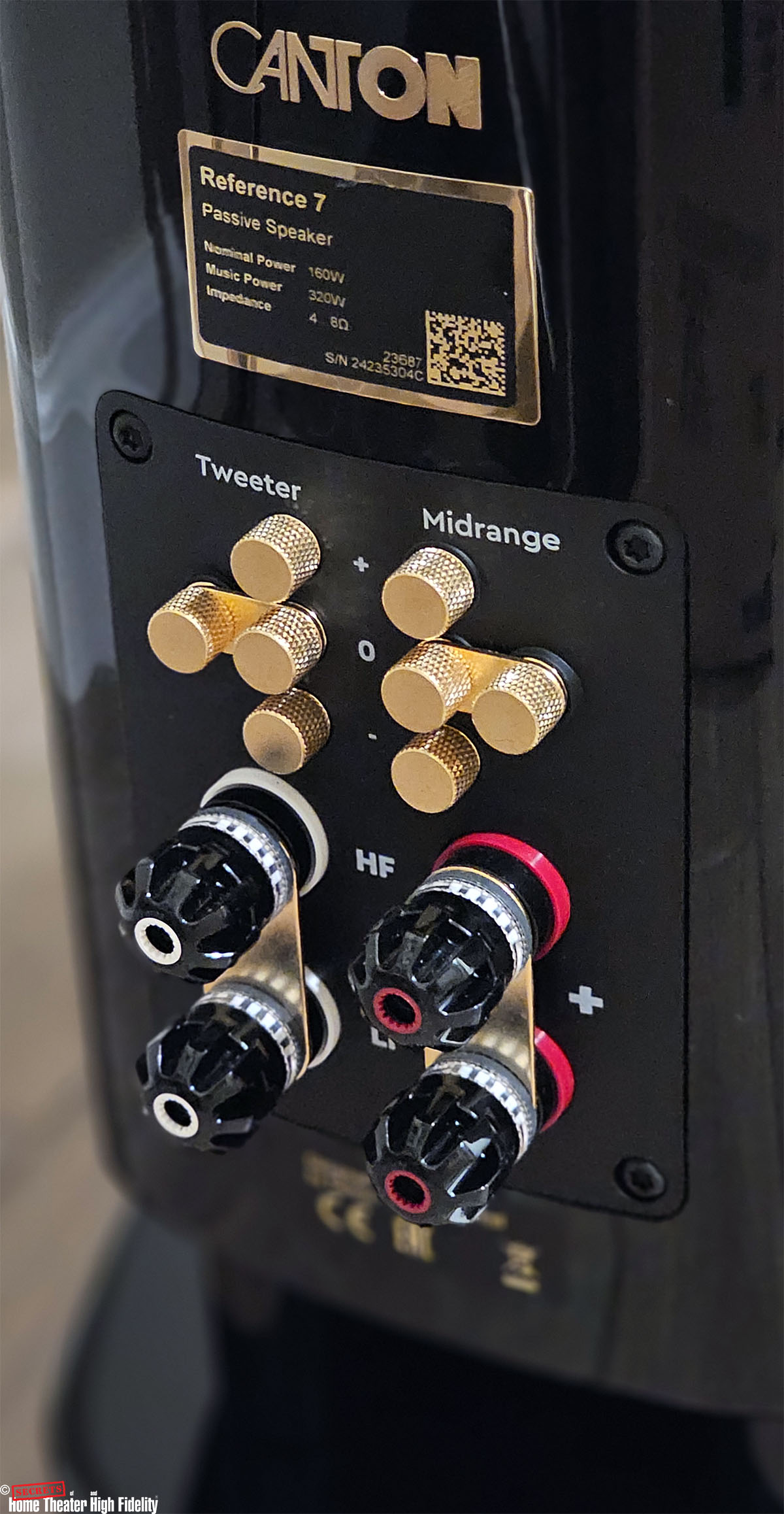 Canton Reference 7 binding posts and tone controls
Canton Reference 7 binding posts and tone controls
Canton provides each Reference speaker with a test report specific to that speaker, signed and dated by the engineer or technician who performed the test. This report includes the frequency- response graph of the speaker in its default settings, as well as with midrange and tweeter adjustments. Such attention to detail is commendable, and I think it gives the product a personalized touch that customers appreciate in general.
During the review, I tested the Reference 7 speakers with amplifiers that I had on hand: the Krell KAV2250 (250/500 W/channel into 8/4 Ohms, paired with the PS Audio BHK Signature preamplifier), the MOON 641 integrated amplifier (125/250 W/channel into 8/4 Ohms), and the Michi X3 integrated amplifier (200/350 W/channel into 8/4 Ohms). Although there were subtle differences among the sonic results, all these pairings produced equally good outcomes and did not change my impression of the tonal characteristics and general performance of the speakers. I used the PS Audio PerfectWave Transport and the AURALiC Aries G1 streamer as the source components during the review in conjunction with the PS Audio DirectStream DAC.
Except for some low-frequency room effects, the in-room on-axis nearfield frequency-response measurement results obtained using the REW software and a calibrated microphone largely aligned with the included factory test reports. The on-axis nearfield response with neutral tone controls was remarkably flat in the 200 Hz to 8 kHz range. A slight elevation was observed in the high-frequency range of 8 – 12 kHz, which did not appear in the 30-degree off-axis frequency response. In fact, the nearfield 30-degree off-axis response showed flatness extending to about 15 kHz. This implies that the optimal orientation of the speakers may not be directly facing the listening position, suggesting the use of minimal or no toe-in for best sonic results. My findings in setting up the speakers confirmed this observation.
 Nearfield (2 ft) frequency response of the Canton Reference 7 speaker with all tone controls in neutral (0) position (green curve: on axis, purple curve: 30 degrees off axis)
Nearfield (2 ft) frequency response of the Canton Reference 7 speaker with all tone controls in neutral (0) position (green curve: on axis, purple curve: 30 degrees off axis)
The effects of midrange and tweeter compensations are also depicted in the subsequent figures. The midrange compensation offers about +/- 1 dB level adjustment in the 100-400 Hz frequency range, while the tweeter compensation incurs a +/- 1 dB level adjustment in the frequency range above 3 kHz. I found that the midrange compensation could be useful in affecting the forwardness of the presentation, which can be influenced by the amplifier used to drive the speakers. With the MOON 641 integrated amplifier, which provides an intimate musical stage portrayal, I preferred to tone down the midrange level to achieve a more neutral stage. On the other hand, with the Krell KAV-2250 amplifier, which is generally quite neutral, my preference was to leave the midrange compensation at ‘0’. The tweeter adjustment might be useful to compensate for overly bright room acoustics or for pairing with amplifiers that have some deviation from neutrality at the upper frequency end. Since my room acoustics were relatively neutral and none of the amplifiers I tried exhibited such characteristics, leaving this tweeter adjustment at ‘0’ yielded the best results. Your sonic preferences should dictate which adjustments need to be applied in your situation.
Nearfield (2 ft) frequency response of the Canton Reference 7 speaker with (a) midrange and (b) tweeter level adjustments (shown within the rectangular dashed boxes)
The bass response of the Reference 7 speakers was not significantly affected by the distance from the wall behind them, owing to the downward-firing bass port with a specific bass guide design. Even when placed with their rear baffle approximately 1 foot from the wall, there was no occurrence of bass muddiness or boominess, as is often experienced with rear port designs. To allow sufficient space for optimal imaging, the speakers were positioned so that their front baffles were approximately 4 feet away from the wall behind them. Consistent with the frequency response measurement results, no toe-in was applied to ensure the most balanced sonic characteristics. In the final review configuration, the speakers were set apart by 8 feet, with my listening position approximately 9 feet from the speakers. The grilles were removed during the listening evaluation.
 Frequency response of the Canton Reference 7 speakers at the listening position with all tone controls in neutral (0) position and no toe-in
Frequency response of the Canton Reference 7 speakers at the listening position with all tone controls in neutral (0) position and no toe-in
Measured at the listening position in their final setup position, the frequency response that the Reference 7 speakers generated exhibited a respectable flatness with bass response extension down to about 25 Hz. Indeed, the bass response of these speakers was remarkably strong for their size.
In my listening evaluation, the Reference 7 speakers sounded as good as their measurements suggested. The speakers exhibited neutral sonic characteristics without emphasizing or de- emphasizing certain frequency bands. Consequently, the Reference 7 speakers sounded well balanced across the audible frequency spectrum with perceptively accurate tonal presentation. Their midrange was coherent and solid, treble was detailed and airy, and bass was punchy and articulate. Their sonic presentation was full of texture and consistently engaging. The speakers were highly transparent and, in a proper setup, capable of effortlessly projecting a wide and deep soundstage. Overall, these Reference 7 speakers impressed me with their refined sonic performance and lack of apparent deficiencies.
I listened to various music through the Reference 7 speakers and was always satisfied with what I heard. Here are some that exemplify the sonic prowess of the speakers.
 Diana Krall’s Wallflower (2014) album cover
Diana Krall’s Wallflower (2014) album cover
Diana Krall, “Wallflower”
The rendition of the track “Sorry Seems to be the Hardest Word” from Diana Krall’s album Wallflower (2014) sounded exceptionally engaging through the Reference 7 speakers. Diana Krall’s voice was reproduced naturally with realistic sibilance and proper conveyance of her breathing as captured in the recording. The speakers effectively portrayed the intimate soundstage of the track, with the depth and layering of the accompanying instruments vividly rendered within the projected three-dimensional soundstage. The liquidity in the speakers’ presentation enhanced the emotional engagement with the music beyond what many other speakers could achieve.
 Green Day’s Greatest Hits: God’s Favorite Band (2017) album cover
Green Day’s Greatest Hits: God’s Favorite Band (2017) album cover
Green Day, “Greatest Hits: God’s Favorite Band”
The Reference 7 speakers performed admirably across various types of music, from serene acoustic music to the dynamic rock genre. Their prowess in untangling complex musical textures and delivering impactful bass was evident in the track “Wake Me Up When September Ends” by the rock band Green Day from their album Greatest Hits: God’s Favorite Band (2017). This track contains busy and complex passages that can become muddled through less capable speakers. However, the Reference 7 effortlessly navigated the interwoven sounds of various instruments, reproducing them with exceptional clarity while preserving their intricate texture. The sonic impact of the kick drum, prominently featured and becoming more pronounced about one third into the track, was conveyed with such authority through the Reference 7, heightening the sense of liveliness of the whole presentation.

Michael Bublé, “Love”
Some speakers may be technically proficient, but they can lack the musicality to invoke the listener’s emotion. The Reference 7 speakers, however, excel in both areas. They are technically solid and possess a sonic quality that effectively engages the listener. This can be attributed to the speakers’ ability to present rhythm and pace in the music as well as the scale of the presentation comprehensively. This was exemplified by the soulful track “My Funny Valentine” from Michael Bublè’s album Love (2021), which was performed in a large ensemble setting. Michael Bublè’s voice, vividly appearing from the front center of the stage, sounded natural and palpable. The sounds of various instruments seemed to emanate from their distinct positions in the wide and deep stage projected by the speakers. The Reference 7 speakers eloquently conveyed the scale of the music with rhythm and pace that represented the mood of the music appropriately. At the beginning of the track, I took note on how the Reference 7 articulately produced the deep bass beat in the music with great authority, how natural the vocal reproduction through the speakers was, and how the projected musical stage preserved the grandeur of the presentation. But as the track progressed, the musicality of the speakers managed to persuade me to forgo all the technicalities and just engage with the flow of the music. This demonstrates the effectiveness of the Reference 7 speakers in invoking sonic indulgence in the listener.
How do these Reference 7 speakers compare to Canton’s own Vento 100 speakers (MSRP $6,495 in standard finish or $6,995 in premium finish) that are still in my possession since I reviewed them three years ago (https://hometheaterhifi.com/reviews/speaker/floor-standing/canton-vento-100-floor-standing-speaker-review/)? Performance-wise, there is not much separating the two. The Vento 100 speakers are solid performers in their own right. In direct comparison, however, the Reference 7 perceptively generated punchier bass and a slightly more coherent midrange presentation. Other than that, the other aspects of performance of these two models are relatively neck and neck. Aesthetically, I have a slight preference towards the all-curved baffle design of the Reference 7. Additionally, the Reference 7 wins out in its provision for midrange and tweeter compensation to tailor to one’s sonic preference and to achieve better synergy with the rest of the components.
Secrets Sponsor
The Canton Reference 7 speakers feature excellent design and performance that are well worth their price tag.
- Excellent build quality and finish.
- Aesthetically elegant appearance.
- Custom-fit magnetically attached grilles.
- Rich in texture and a well-balanced response across the audible frequency spectrum.
- Great soundstage projection.
- Eloquent conveyance of musical rhythm and pace.
- None.
Canton continues to impress with its Reference 7 speakers, much like my previous experience with the Vento 100. These speakers exemplify high-fidelity audio performance while maintaining an impeccable balance between form and function. The build quality is robust, and the all-curved baffle design adds an air of elegance and aesthetic appeal, complemented by a refined finish. Throughout my evaluation, the Reference 7 speakers demonstrated exceptional sonic capabilities, meeting all criteria for high-fidelity sound reproduction convincingly. This seamless integration of form and function suggests that the Canton Reference 7 speakers offer substantial value, justifying their price point. For discerning audiophiles looking for slim floor-standing speakers, I highly recommend putting these speakers on your short audition list.


